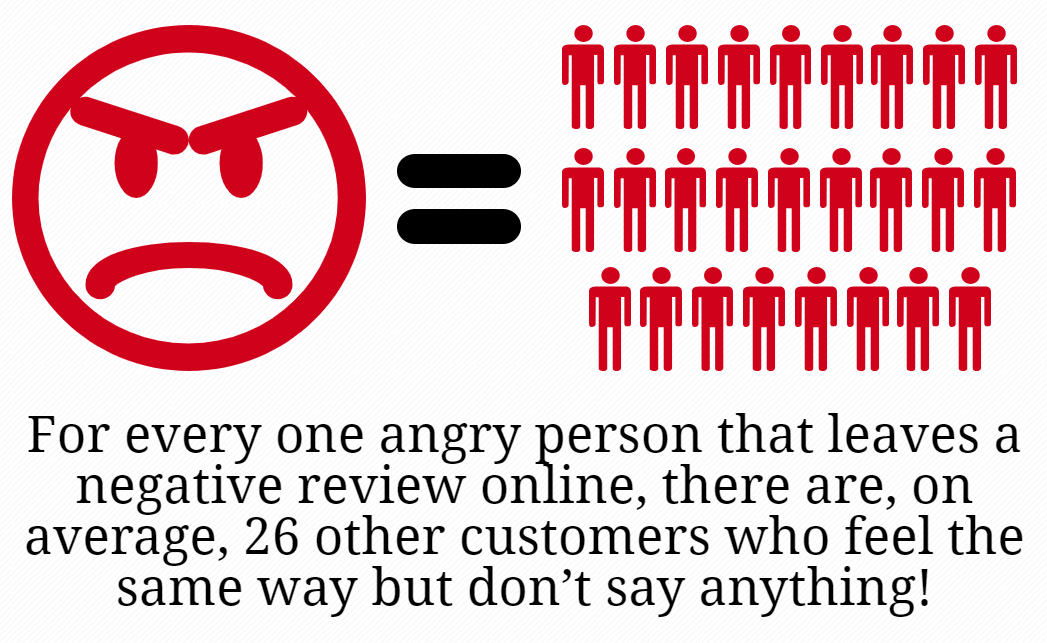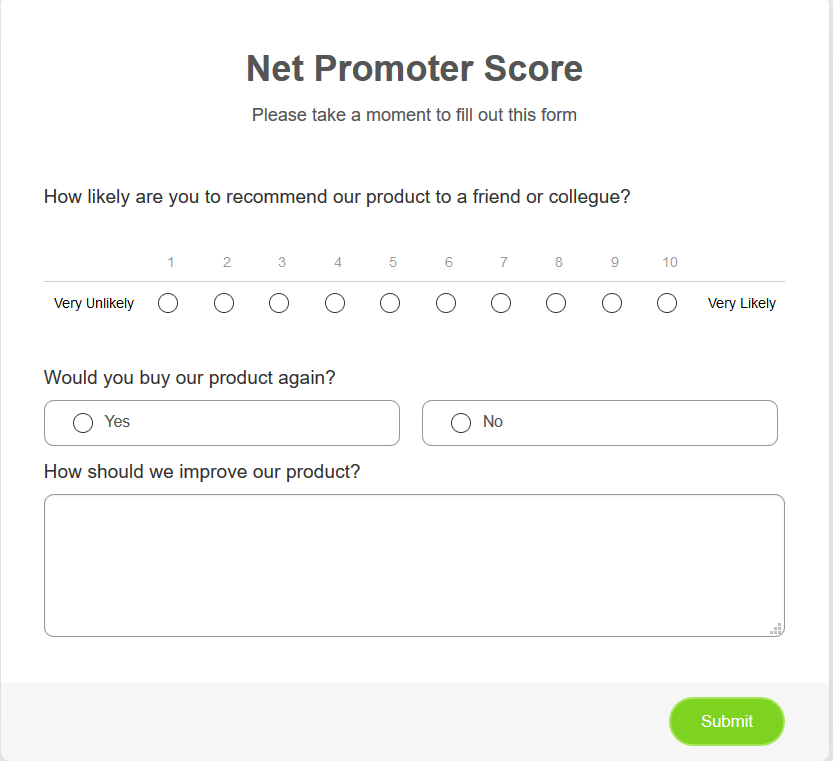Did you know that for every one negative review online, there are, on average, 26 other customers who feel the same way but don’t say anything?
 In addition, 86 percent of people will hesitate to make a purchase from a business that has several negative reviews.
In addition, 86 percent of people will hesitate to make a purchase from a business that has several negative reviews.
One of the best ways to improve overall customer experience and get more positive reviews on sites like Yelp, TripAdvisor, etc., is to be proactive. Feedback forms can help you do this.
In this post, we’re going to talk about several ways you can use customer feedback forms to better understand your customers.
What is a Customer Feedback Form and Why is it Important?
At its simplest, a feedback form allows you to get a pulse on how your customers feel about your brand, products, and customer support.
In a time where 89 percent of people have gone to a competitor after a bad customer service experience, having solid customer feedback systems and processes in place can be the difference between thriving and going out of business.
Feedback forms aren’t one size-fits-all solutions. They can be everything from customer satisfaction surveys and event satisfaction forms to website surveys, demographic surveys, and restaurant feedback forms.
(Note: If you’re looking for ideas about how to structure your process, here are some feedback form templates.)
Figure Out “Your Ask”
One of the most important things you should think about is how you’re going to frame your feedback request.
Most people won’t give you feedback unless you ask for it. How you ask for feedback makes all the difference in the quality of the feedback you get.
Here are some tips to keep in mind:
- Identify why you need this feedback. What’s the purpose? What’s the ideal outcome?
- Who is the best person to ask? Good feedback from the wrong person is still bad feedback.
- Be considerate of your customers’ time. The quicker and easier it is for them to give feedback, the more likely they will do it. For example, don’t send a 20-question survey when three questions would do.
- Many businesses are now embedding QR codes on receipts, product packaging, or even inside store displays to make leaving feedback effortless. Customers simply scan and respond on the go — no app or login required. Tools like Google Forms, Typeform, or QR code platforms such as Uniqode’s QR tracking make it easy to monitor responses and see which locations or channels are generating the most engagement. This helps you collect high-quality insights without disrupting the customer journey.
Build Trust With Your Customers
Communication is key to building and maintaining great relationships. One way to do that is by asking for customer feedback on a regular basis, then listening and responding to what your customers tell you.
For example, you can send a short follow-up survey after a customer buys a product or service. Most brands are notoriously bad at following up with their customers. They either don’t follow up at all (not good) or they follow up at the wrong time.
Say you sell enterprise CRM software that takes an average of 90 days to be integrated into a company’s systems and processes. You don’t want to send a follow-up feedback survey the day after you close the sale.
 (Source)
(Source)
At best, you’ll get feedback that isn’t particularly helpful because the customer hasn’t had a chance to actually use the product yet; at worst, you’ll end up annoying a new customer.
In this case, it would be a better idea to ask for feedback at the 90-day mark. By this point, the customer has experienced enough of your product to provide relevant and helpful feedback.
Once you receive feedback, make sure to treat it as a gift. If a customer is willing to take the time to give you feedback — good or bad — it means that they care. The way you respond has a big impact on the customer’s experience and their perceptions of your brand.
Provide Proactive Customer Support
In addition, you can rely on feedback forms to identify unhappy customers before they get to the point that they leave a negative review or churn out.
One great customer feedback form to use in this case is the Net Promoter Survey (aka NPS).
 (Source. Example of an NPS survey. You can send this quarterly to all customers or simply add it as a follow-up email anytime a customer reaches out to your support team.)
(Source. Example of an NPS survey. You can send this quarterly to all customers or simply add it as a follow-up email anytime a customer reaches out to your support team.)
NPS measures on a scale of 1–10 how likely users are to refer your product or service to their friends or colleagues:
- 0–6: detractors
- 7–8: neutrals
- 9–10: promoters
Follow up with all of your detractors. While it can be hard not to take negative feedback personally, it helps to remember that an angry customer isn’t usually mad at you but at the situation in general.
You’ll often find yourself surprised by the impact of a candid dialogue with these customers. The most vocal, negative customers can turn into product evangelists or superfans in a matter of months.
Build Relationships With Superfans
In addition to reaching out to detractors, you should also reach out to promoters. These are your superfans.
 (Source)
(Source)
Did you know that 72 percent of customers will share a positive experience with six or more people?
When someone leaves a positive response to your feedback form, you should reach out and thank them. Most companies stop there (if they even do that). Don’t be like most companies; start an ongoing dialogue with your superfans.
Happy customers can be great sources of testimonials, customer success stories, and even great people to test out new products or services as beta testers.
Build Out Your Self-Service Support Channels
One of the best ways to increase the amount of customers you can help and the quality of the experience they have is by investing in a knowledge base and/or customer support forum.
One thing that often happens is that companies invest in building out a knowledge base but then forget to update it regularly.
Creating a feedback form on each support article allows you to gather real-time feedback. You can then identify which articles are the most helpful, which ones need updates, and what content you should create next.
You can take this a step further and share the feedback with your product team. For example, if you know a lot of people get stuck on a specific feature and reference one support article, you can share that with a product manager. Then, they can use that to make the feature more intuitive to use.
Improve Your Product
Feedback forms can be a great way to better understand your customers and how they actually use your product and service.
Too often, companies rely on their product and engineering teams for all of this customer information.
You’ll likely find that your customers are using your product in ways you wouldn’t expect. Collecting these insights can help you make your product stronger and build new features or even entirely new products to support these use cases.
As you make these improvements, your customers will take notice. They will be more likely to use the features and share them with their friends. These product improvements end up becoming significant marketing assets.
Get Real Customer Data to Make More Informed Business Decisions
Sending out a feedback form can be great anytime you hit a fork in the road and have to make a big decision.
Here are a few examples of when collecting feedback can be helpful:
- Thinking about pricing changes
- Building a new feature or product
- Redesigning a website and/or a product
- Expanding into a new category or vertical
- Entering a brand-new market
Being willing to listen to your customers during these crucial moments can help guide your decisions, mitigate risk, and keep you from making significant screwups.
Analyze the Customer Feedback You Receive On a Regular Basis
Collecting customer feedback is only one step of the process. It is just as important to analyze it on a regular basis. We’d recommend doing this at least once a month — preferably more.
Build processes for requesting, collecting, and analyzing feedback into all of your team’s systems. For example, you can send customer feedback to your CRM, customer support ticketing platform, a shared Google spreadsheet, or even a special feedback channel in Slack. The more it’s in front of your team, the more likely they are to read, think about, and act on this information.
In addition, it can also help to take a step back and review your feedback processes as a whole on a monthly or quarterly basis. You want to assess what’s working, look for trends, and spot patterns.
Wrapping Up
In conclusion, customer feedback can help your product, engineering, marketing, sales, and support teams better understand all of your customers.
You should treat this feedback as a gift. Your customers don’t owe you feedback. So when they give it to you — whether positive or negative — it means that they care and are invested in your company. Putting processes in place to actively collect and respond to customer feedback will set your business apart from your competitors.
 |
Author Bio: This guest post is contributed by Annabel Maw. |

